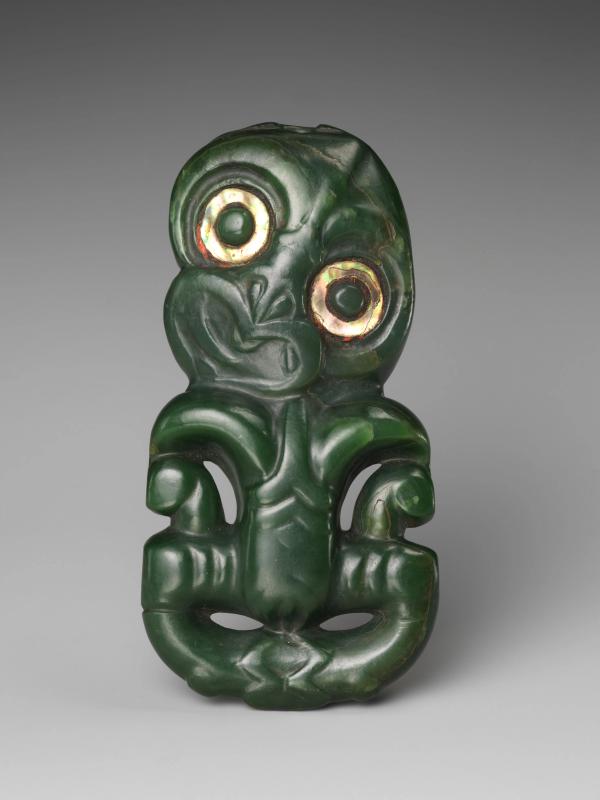Greenstone pendant
Artwork Details
- Title: Greenstone pendant
- Date: 19th century
- Culture: Maori; Aotearoa New Zealand
- Medium: Nephrite jade (pounamu), shell, pigment, and wax
- Dimensions: H. 6 1/8 in. (15.5 cm); W. 3 in. (7.6 cm); D. 1 in. (2.5 cm)
- Classification: Jade
- Credit Line: Gift of Heber R. Bishop, 1902
- Object Number: 02.18.315
- Curatorial Department: Asian Art
Audio

1775. Hei tiki (pendant), Māori artist
Maia Nuku
MAIA NUKU: I thought it might be nice to start with a couple of whakatauki or Māori proverbs that mention pounamu, which is the hard greenstone or nephrite jade which this Māori hei tiki is made from.
One quite famous proverb is this one: Ahakoa he iti, he pounamu. And that means: “Though it is small, it is pounamu,” or a treasure.
Tēnā koutou katoa, I am Maia Nuku and I am the curator for Oceania here at the Metropolitan Museum of Art.
KATERINA TEAIWA (NARRATOR): This hei tiki would have been worn as a pendant necklace. On the back, at the top, there’s a worn-away area where a flax cord would have once passed through.
MAIA NUKU: It’s something that would’ve been worn and kept as an heirloom and passed down.
KATERINA TEAIWA: Look closely at the qualities of this stone. It’s a dark, intense green, like the depths of the riverbed.
MAIA NUKU: There’s a whole vocabulary that describes the different kinds of greenstone.
KATERINA TEAIWA: Most Māori art is made from fragile, ephemeral materials—like wood, feathers, and fiber.
MAIA NUKU: So any material that has a sense of durability and permanence is valued, revered even.
There’s something very embryonic about the sculpture. So, it’s really encapsulating that extraordinary moment where new life is birthed into being.
It’s all of that energy encapsulated into this beautiful, dense stone that you can hold in your hand or wear around your neck.
More Artwork
Research Resources
The Met provides unparalleled resources for research and welcomes an international community of students and scholars. The Met's Open Access API is where creators and researchers can connect to the The Met collection. Open Access data and public domain images are available for unrestricted commercial and noncommercial use without permission or fee.
To request images under copyright and other restrictions, please use this Image Request form.
Feedback
We continue to research and examine historical and cultural context for objects in The Met collection. If you have comments or questions about this object record, please contact us using the form below. The Museum looks forward to receiving your comments.
